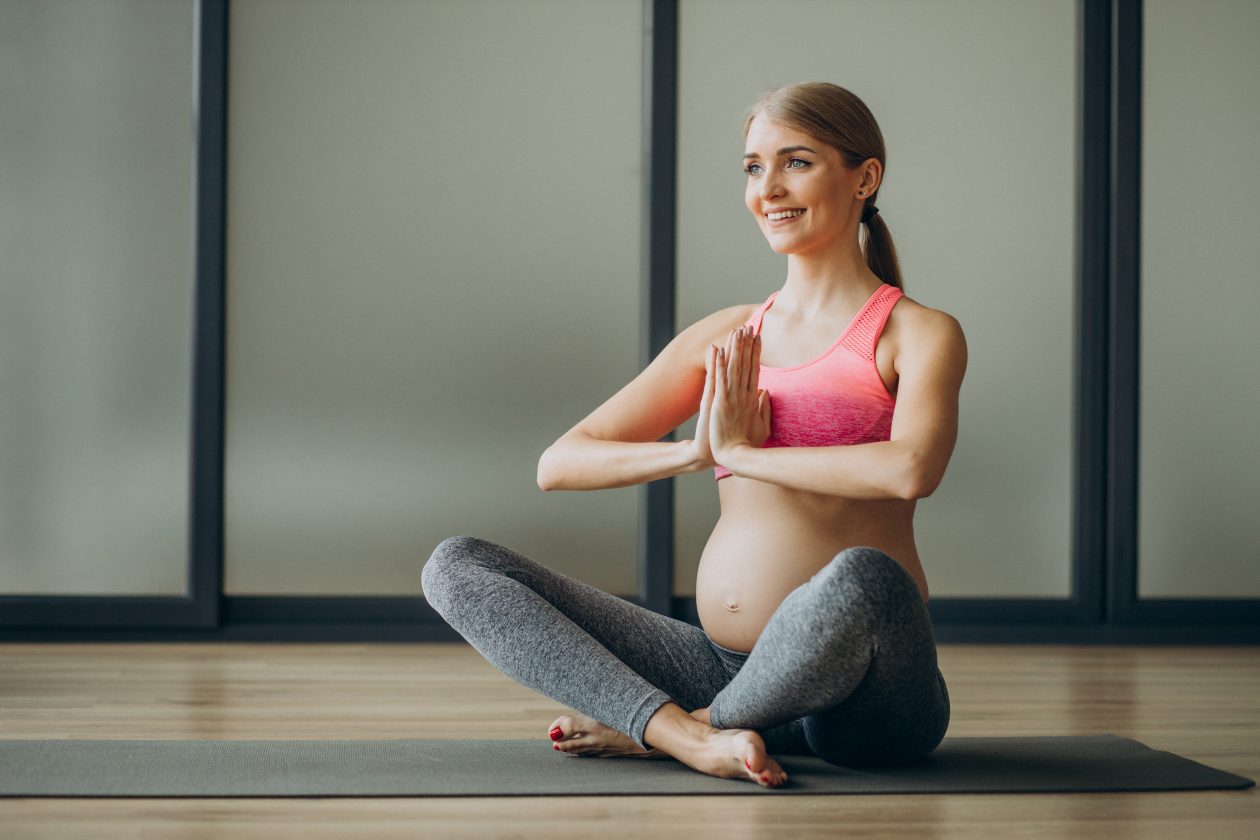Introduction
Pregnant women can benefit from a wide range of yoga poses that support their physical and emotional health during their pregnancy. It encourages relaxation and stress release and offers mild exercise to preserve flexibility and fitness—two essential components during this transition period. Prenatal yoga also helps expectant mothers prepare for childbirth by improving their strength, endurance, and breath control for labor and delivery.
Ensuring that practicing yoga is safe during pregnancy is crucial, highlighting the need for adjustments to account for the body’s changing requirements and limitations. Even though yoga has many benefits, there are some postures and practices that should be avoided or adjusted to avoid pain or potential harm to the mother and the unborn child. It is also essential to consult with trained prenatal yoga instructors and healthcare professionals to customize the practice to meet the needs of each trimester and individual circumstances. Pregnant women who prioritize safety and modification can maximize the benefits of yoga while lowering hazards.
Benefits of Prenatal Yoga

Back pain, swollen ankles, and pelvic pressure are among the frequent pregnancy discomforts that prenatal yoga effectively relieves. Throughout pregnancy, pregnant women can enhance their general comfort and well-being by reducing muscle and joint tension with gentle stretches and poses designed just for them.
Pregnant women who practice prenatal yoga gain vital skills for labor and delivery. Expectant mothers can improve their endurance and resilience, which will help to facilitate a more comfortable birthing experience, by engaging in targeted activities that focus on strengthening the core muscles, increasing stamina, and practicing controlled breathing methods.
Prenatal yoga integrates mindfulness and relaxation practices to support the mental and emotional health of expectant mothers. Through the hormonal shifts and emotional difficulties of pregnancy, mindful breathing, meditation, and guided relaxation techniques can develop a sense of calm and balance by lowering tension, anxiety, and mood swings.
Prenatal yoga sessions offer expectant mothers a supportive network of other soon-to-be parents. Connecting with like-minded individuals fosters empathy and understanding, providing crucial emotional assistance and a support system for managing pregnancy and the early stages of parenthood.
Prenatal yoga has been linked in studies to lower blood pressure in pregnant moms, which in turn lowers the risk of pregnancy problems, including preeclampsia. Yoga’s calming poses, stress-relieving methods, and gentle movements support cardiovascular health and the well-being of the mother and the unborn child.
Prenatal yoga fosters conscious nutrition and physical activity, which helps pregnant moms maintain a healthy weight throughout the pregnancy. Pregnant women can make decisions promoting consistent weight growth and optimal metabolic function, leading to a healthy pregnancy and postpartum recovery by raising knowledge of their changing bodies and nutritional demands.
Pregnancy Yoga by Trimester

Many women have symptoms like exhaustion and nausea throughout the first trimester of pregnancy. With an emphasis on soft movements and breathwork, pregnancy yoga catered to this stage of pregnancy helps reduce discomfort and encourage relaxation. In addition to offering relief, stretches like Cat-Cow, slow twists, and mindful breathing techniques can assist the body’s shifting demands. During this transitional period, paying attention to your body and avoiding overdoing it is essential. Yoga can be a gentle approach to keep active and connected.
Pregnant women can participate in more vigorous yoga sessions to increase their strength and flexibility since their energy levels usually rise during the second trimester. Maintaining muscular tone and preparing the body for the physical demands of labor can be achieved with modified sun salutations, standing poses like Warrior II, and hip-opening stretches. Including healing poses and exercises for the pelvic floor promotes stability and balance while developing a closer bond with the developing baby. To maintain comfort and safety, respecting your body’s limitations and adjusting postures is critical.
As the baby grows, the body experiences significant center of gravity and balance changes during the third trimester. Prenatal yoga practices at this stage emphasize stability, posture, and relaxation to support the body’s changing demands. Using props like chairs, bolsters, and blocks can add strength and support during standing and sitting poses. Supported backbends, gentle hip openers, and breathing exercises like Ujjayi Pranayama relieve pain and prime the body for birthing. It’s imperative to cultivate self-compassion and mindfulness to embrace and gracefully navigate the process of pregnancy.
Where to Practice Prenatal Yoga
Pregnant women who attend in-person prenatal yoga courses can work with professional instructors in a safe setting, receiving guidance and support. Yoga studios frequently provide prenatal sessions designed specifically for pregnant women, emphasizing safe and beneficial poses for every trimester. Additionally, prenatal yoga classes taught by qualified instructors may be held at community centers, hospitals, and birth centers. These sessions offer the knowledge of experts trained in prenatal yoga instruction and a feeling of community and camaraderie among expecting mothers. Ensure the instructor of an in-person class you choose is qualified in prenatal yoga and informed about adaptations for pregnancy.
Online prenatal yoga sessions are an excellent substitute for pregnant women with limited access to in-person programs or who would instead practice yoga at home. Expectant mothers can practice at their own pace and on their schedule with prenatal yoga programs offered by licensed instructors on several trustworthy yoga websites and platforms.
Pregnancy-safe and successful practices are ensured by the comprehensive alignment and adjustment instructions frequently included in online programs. Women practicing yoga at home can also tailor their regimens to suit their requirements and tastes. Investing in appropriate yoga props like blocks, bolsters, and straps is critical to enhance stability and alignment during at-home yoga practices. It’s best to speak with a healthcare professional before beginning any online course to make sure the chosen regimen is appropriate for one’s stage of pregnancy and general health.
Prenatal yoga is accessible to women via online and in-person formats, allowing them to select the best fit for their needs, schedules, and lifestyles and guaranteeing a positive and safe yoga experience through pregnancy.
What to Expect in a Prenatal Yoga Class
Prenatal yoga programs usually have a set structure intended to meet the specific requirements of expectant mothers at various phases of their pregnancy. To create a friendly and encouraging atmosphere, these programs frequently start with a brief introduction during which pregnant moms can get to know their teachers and other students. Stretches and mild motions are the main focus of the warm-up to prime the body for more dynamic poses while increasing circulation and suppleness.
Participants in the class perform a sequence of standing poses designed to increase muscle mass, enhance balance, and release tension in the body. Breathing exercises, including pranayama techniques, are used with other methods to improve consciousness, lower stress levels, and increase relaxation. The course ends with a calming cool-down that enables students to decompress and wind down, leaving them feeling renewed and invigorated.
Prenatal yoga sessions emphasize safety and incorporate adaptations specific to each trimester of pregnancy, which is one of their main advantages. Pregnant women’s safety and well-being are the top priority for certified instructors, who lead them through safe and healthy poses and movements. Pregnant women’s bodies change with each trimester, and modifications are made to meet their evolving demands and restrictions. These adjustments could involve changing the intensity or using supports or posture adjustments to guarantee comfort and stability. Prenatal yoga courses provide customized teaching and specific attention to women, enabling them to practice yoga safely and confidently throughout their pregnancies.
Participants and teachers must communicate well in prenatal yoga courses to address any discomfort or concerns that may develop during practice. It is suggested that expectant mothers be open and honest with their instructors about their physical state, their restrictions, and any symptoms they may be having linked to pregnancy. Instructors can offer individualized assistance and change to fit the unique needs of each participant by creating a supportive and non-judgmental environment. Furthermore, teachers could provide substitute positions or modifications to guarantee students’ comfort and security during the lesson. Transparent communication between students and teachers builds trust, improves the yoga practice, and supports general pregnant well-being.
In conclusion, pregnant moms can safely and efficiently practice yoga throughout their pregnancy in a supportive setting provided by prenatal yoga courses. As women traverse the path of pregnancy and prepare for childbirth, these sessions offer invaluable support and assistance by adhering to a prescribed format, emphasizing safety, and promoting open communication.
Top Pregnancy Yoga Poses to Know

Pregnancy yoga provides a variety of helpful positions designed to accommodate pregnant moms’ evolving requirements. Pregnant ladies are advised to do the following top poses:
A. Cat and Cow Pose
Description: This mild spine movement alternates between rounding and arching the back on all fours. It facilitates relaxation, flexibility, and the relief of lower back and pelvic stiffness.
Benefits: Reduces back strain, stimulates abdominal organs, and enhances blood flow to the pelvic area.
B. Goddess Pose:
Description: Also called Utkata Konasana, the Goddess Pose is a standing pose with bent legs, but the spine remains straight. This position eases lower body stiffness, expands the pelvis, and extends the groin and inner thighs.
Benefits: Promotes ideal fetal posture, strengthens the legs, hips, and pelvic floor muscles, enhances circulation, and prepares the body for childbirth.
C. Anjaneyasana with a Side Lean
Description: The Low Lunge, or Anjaneyasana, is executed by bringing the back knee down to the floor and putting one foot forward into a lunge pose. Intense hip flexor stretch and abdominal space are created by adding a side lean toward the front leg.
Benefits: Releases tension in the hips and pelvis; stretches the thighs, groin, and hip flexors; enhances stability and balance during pregnancy.
D. Wide-Legged Squat
Description: Stand with your feet wider than hip-width apart to achieve this pose. Bend your knees into a squat while maintaining a straight back. It relieves pelvic pressure, opens the pelvic inlet, and relaxes the pelvic floor muscles.
Benefits: Promotes ideal fetal positioning for labor, strengthens the legs, hips, and pelvic floor, and develops flexibility in the groin and hips.
Pregnant women can preserve their physical and mental health by including these yoga positions in their prenatal practice. Pay attention to your body, exercise mindfully, and speak with a doctor before beginning a new fitness regimen while pregnant. Women who regularly practice prenatal yoga can feel more at ease, strong, and at ease as they prepare for childbirth and motherhood.
Safety Precautions for Prenatal Yoga
It is crucial to ensure safety when doing prenatal yoga to safeguard the mother and the unborn child. Here are some essential safety measures to think about:
After 20 weeks of pregnancy, pregnant women should refrain from positions that require them to lie flat on their backs. The vena cava, a significant blood vessel, may be compressed in this position, which could lower blood flow to the uterus and impact the embryonic oxygen supply. It is advised to use pillows or bolsters to keep oneself raised and at a little inclination when laying flat on one’s back or to lie on one’s side to provide the baby with the best possible blood circulation.
Pregnancy can benefit from particular twisting and back-bending positions, but these should only be done sparingly and carefully. Excessive back bends can strain the back and abdominal muscles, while deep twists might compress the abdomen and hinder digestion. It is recommended to perform backbends and mild twists to prevent overstretching and preserve abdominal space. Concentrate on opening the shoulders and chest rather than straining to be as flexible as possible.
Staying hydrated during pregnancy is essential, especially when engaging in vigorous activities like yoga. During practice, expectant mothers should pay attention to their bodies and respect their energy levels. Fatigue, thirst, or hyperthermia might result from pushing yourself too hard or overexertion. Staying hydrated before, during, and after yoga practices is advised. Pause as necessary, rest in savasana or child’s pose and adjust positions to your comfort level. Be mindful of any indications of pain, lightheadedness, or dyspnea, and modify as necessary.
Expectant mothers can reap yoga’s many health benefits while lowering their chance of harm or difficulties by taking some safety steps and paying attention to their bodies’ signals. Before beginning any new fitness program while pregnant, you must speak with your doctor. It would help if you also practiced yoga under the supervision of a certified prenatal yoga instructor. Prenatal yoga can be a safe and proper technique to enhance general well-being throughout pregnancy, provided that it is done with mindfulness, awareness, and the appropriate safety precautions.
FAQs About Yoga for Pregnant Women
Q: Which yoga is best during pregnancy?
A: Prenatal yoga, specifically designed for expectant mothers, is the best choice during pregnancy. It focuses on gentle poses, breathing techniques, and relaxation exercises tailored to the needs of pregnant women, promoting physical and emotional well-being throughout all stages of pregnancy.
Q: Is it safe to do yoga during pregnancy?
A: Practicing yoga during pregnancy is generally safe and beneficial for most expectant mothers. However, it’s essential to consult with a healthcare provider before starting any new exercise regimen, especially during pregnancy, to ensure that yoga suits individual circumstances.
Q: Which month is best for yoga in pregnancy?
A: Pregnant women can start practicing yoga at any stage of pregnancy, but the first trimester may require modifications to accommodate symptoms like nausea and fatigue. However, many women find the second trimester the most comfortable time for yoga practice, as energy levels tend to improve, and the risk of complications is lower.
Q: Is yoga good for getting pregnant?
A: While yoga can promote overall health and well-being, including reproductive health, there’s limited evidence to suggest that yoga alone can increase fertility or improve the chances of conception. However, yoga can help manage stress, promote relaxation, and support a healthy lifestyle, which may indirectly contribute to fertility.
Q: What should you avoid in yoga when pregnant?
A: Pregnant women should avoid poses that involve lying flat on the back after the first trimester, deep twists, back bends, abdominal solid contractions, and poses that require balancing on one leg for extended periods. Additionally, listening to the body and avoiding overexertion or pushing beyond comfortable limits is essential.
Q: Can I do yoga in the first month of pregnancy?
A: Yes, gentle yoga practices are generally safe in the first trimester of pregnancy. However, it’s essential to inform the instructor about the pregnancy and listen to the body’s cues. Some women may experience fatigue or nausea during this time, so modifications may be necessary.
Q: How many times should I do yoga during pregnancy?
A: The frequency of yoga practice during pregnancy can vary based on individual preferences and physical condition. Many experts recommend practicing prenatal yoga at least 2-3 times per week to experience its benefits, but it’s essential to listen to the body and avoid overdoing it.
Q: Does yoga make childbirth easier?
A: While there’s no guarantee that yoga will make childbirth more accessible, it can help prepare the body and mind for birthing. Prenatal yoga focuses on building strength, flexibility, and breath awareness, which can be beneficial during labor and delivery. Additionally, yoga promotes relaxation and stress reduction, which may contribute to a more positive birth experience.
Q: Can I do yoga in the second trimester?
A: The second trimester is often considered the most suitable time for yoga practice during pregnancy. Most women experience increased energy levels and reduced discomfort during this trimester, making engaging in physical activity like yoga easier. However, listening to the body and modifying poses as needed is essential.
Q: Does yoga help in expected delivery?
A: While yoga cannot guarantee a standard delivery, it can support overall health and well-being during pregnancy, which may contribute to a smoother labor and delivery process. Prenatal yoga focuses on building strength, flexibility, and relaxation, which can be beneficial during childbirth.
Q: Can I do butterfly yoga in pregnancy?
A: The butterfly pose, also known as Baddha Konasana, can be practiced during pregnancy with modifications to accommodate the growing belly. It helps open the hips and groin area, which can be beneficial for pregnant women preparing for childbirth. However, it’s essential to practice this pose mindfully and avoid overstretching.
Q: Is it reasonable to walk while pregnant?
A: Walking is an excellent form of exercise during pregnancy, providing numerous physical and mental health benefits. It helps improve cardiovascular fitness, maintain a healthy weight, reduce stress, and boost mood. Pregnant women should aim for at least 30 minutes of moderate-intensity walking most days of the week unless advised otherwise by a healthcare provider.
Q: Is pregnancy yoga the same as regular yoga?
A: Pregnancy yoga, also known as prenatal yoga, differs from regular yoga in that it is specifically tailored to the needs of expectant mothers. Prenatal yoga classes focus on poses, breathing techniques, and relaxation exercises that are safe and beneficial during pregnancy, addressing common discomforts and preparing women for childbirth.
Q: When should I stop bending during pregnancy?
A: Pregnant women can continue to bend and move during pregnancy, but it’s essential to do so mindfully and with proper form. As the pregnancy progresses, women may need to modify bending movements to accommodate the growing belly and avoid strain on the back and abdominal muscles. If bending becomes uncomfortable or challenging, listening to the body and adjusting as needed is essential.
Conclusion
With its all-encompassing approach to promoting expectant mothers’ physical and mental well-being throughout their pregnancy, prenatal yoga is becoming an increasingly important tool for expecting mothers. Prenatal yoga offers expectant mothers a unique way to connect with their bodies and develop kids by emphasizing gentle practices, breathwork, and mindfulness. This practice gives women the tools to handle pregnancy’s physical changes and discomforts more gracefully and efficiently by encouraging calm, strength, and flexibility.
Prenatal yoga is a haven for pregnant mothers to develop mental and emotional fortitude in addition to its physical advantages. Women who are pregnant or have given birth can reduce their stress, anxiety, and concerns by practicing relaxation techniques, meditation, and visualization. Prenatal yoga gives women the confidence and optimism to fully embrace the life-changing experience of pregnancy by fostering a sense of serenity and inner peace.
Finally, prenatal yoga addresses the various demands and worries of pregnant moms by providing a comprehensive approach to pregnancy care. Women who incorporate this practice into their prenatal routines can improve their physical health and well-being and foster a stronger bond with themselves and their unborn children. Prenatal yoga is an invaluable resource for assisting women through every stage of pregnancy and enabling them to welcome motherhood with courage, resiliency, and joy because of its emphasis on safety, mindfulness, and self-care.
Reference
Žebeljan, I., Lučovnik, M., Dinevski, D., Lackner, H. K., Moertl, M. G., Dinevski, I. V., & Mujezinović, F. (2022). Effect of Prenatal Yoga on Heart Rate Variability and Cardio-Respiratory Synchronization: A Prospective Cohort Study. Journal of Clinical Medicine, 11(19). https://doi.org/10.3390/jcm11195777
“Pregnancy Yoga: Poses for the First Trimester.” 2023. The Art of Living – Making Life a Celebration. September 25, 2023. https://www.artofliving.org/in-en/yoga/yoga-sequences-for/pregnancy-yoga-poses-for-the-first-trimester.
Mary Anne Dunkin. 2010. “Back Pain in Pregnancy.” WebMD. WebMD. January 13, 2010. https://www.webmd.com/baby/back-pain-in-pregnancy.
Ezrin, Sarah. 2018. “Yoga for Lower Back Stretching.” Healthline. Healthline Media. May 22, 2018. https://www.healthline.com/health/yoga-for-lower-back-stretching#Takeaway.
Styles, Amanda, Virginia Loftus, Susan Nicolson, and Louise Harms. 2019. “Prenatal Yoga for Young Women: A Mixed Methods Study of Acceptability and Benefits.” ResearchGate. Springer Nature. November 28, 2019. https://www.researchgate.net/publication/337619643_Prenatal_yoga_for_young_women_A_mixed_methods_study_of_acceptability_and_benefits.
APA Admin. 2017. “Prenatal Yoga.” American Pregnancy Association. August 28, 2017. https://americanpregnancy.org/healthy-pregnancy/pregnancy-health-wellness/prenatal-yoga/.
Editor. 2020. “Pregnancy Weight Gain Chart.” American Pregnancy Association. April 27, 2020. https://americanpregnancy.org/healthy-pregnancy/pregnancy-health-wellness/pregnancy-weight-gain/.
Was this helpful?

Joseph Emb, RDN
Founder of StyleVitally.com | Registered Dietitian & Wellness Advocate
What I Cover:
I’m passionate about connecting nutrition science and everyday wellness to help people live healthier, more vibrant lives. I write about evidence-based nutrition, mindful eating, sustainable lifestyles, and holistic well-being at StyleVitally.com.
My Background:
The University of Texas in Austin, where I earned my Dietetics diploma, laid the groundwork for my nutrition and health career. My training and hands-on experience taught me the science and art of using nutrition to enhance health and well-being.
Professional Journey:
I’m an RDN with lots of experience. I’ve helped people seeking tailored nutritional recommendations in clinical settings and community outreach programs. My constant learning and professional development ensure that my recommendations are always based on the latest evidence.
Ethical Commitment:
My practice prioritizes integrity. My content is transparent and objective, following the most significant ethical standards. I can give my audience unbiased advice because I’m not affiliated with food businesses or industry associations. I want to help people make informed health decisions that match their values and ambitions.
Join Me on the Wellness Journey:
Join me on the path to vitality and well-being, whether facing nutritional issues, seeking sustainable lifestyle changes, or simply wanting a better, happier you. We’ll discover how diet, mindfulness, and holistic well-being can maximize your potential.






